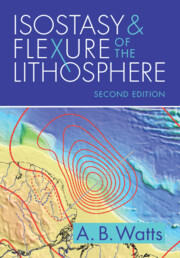Book contents
- Isostasy and Flexure of the Lithosphere
- Isostasy and Flexure of the Lithosphere
- Copyright page
- Dedication
- Contents
- Preface to the Second Edition
- Preface to the First Edition
- Acknowledgements
- Notation
- 1 The Development of the Concept of Isostasy
- 2 Isostasy and Flexure of the Lithosphere
- 3 Theory of Elastic Plates
- 4 Geological Examples of the Flexure Model of Isostasy
- 5 Isostatic Response Functions
- 6 Isostasy and the Physical Nature of the Lithosphere
- 7 Isostasy and the Origin of Geological Features in the Continents and Oceans
- 8 Isostasy and the Terrestrial Planets
- References
- Index
3 - Theory of Elastic Plates
Published online by Cambridge University Press: 28 September 2023
- Isostasy and Flexure of the Lithosphere
- Isostasy and Flexure of the Lithosphere
- Copyright page
- Dedication
- Contents
- Preface to the Second Edition
- Preface to the First Edition
- Acknowledgements
- Notation
- 1 The Development of the Concept of Isostasy
- 2 Isostasy and Flexure of the Lithosphere
- 3 Theory of Elastic Plates
- 4 Geological Examples of the Flexure Model of Isostasy
- 5 Isostatic Response Functions
- 6 Isostasy and the Physical Nature of the Lithosphere
- 7 Isostasy and the Origin of Geological Features in the Continents and Oceans
- 8 Isostasy and the Terrestrial Planets
- References
- Index
Summary
Flexure is an important feature of deep-sea trench–outer rise systems. In particular, the topographic rises seaward of deep-sea trenches can be explained by vertical and horizontal loads that act on the approaching oceanic lithosphere. While the source of these loads is not always clear, they combine to flex the lithosphere downwards by a few kilometres at the trench and upwards by several hundreds of metres in the region of the topographic rise. Many of the differences in the bathymetry of deep-sea trench–outer rise systems can be explained by variations in Te of the approaching plate. Others may be due to variations in the state of stress that exist across the plate boundary. There is evidence that the flexure is large enough at some trenches to locally weaken the lithosphere and cause it to fail through normal faulting. Seamounts and oceanic islands that ‘ride’ the topographic rise will experience uplift and then subsidence as they are carried by plate motions into the trench. This will also be the case for continents that arrive at a trench because of the subduction of oceanic crust. Uplift is in the process of affecting New Caledonia and other neighbouring islands, and flexure seaward of trenches may explain several erosional unconformities that are observed in the ancient rock record.
Keywords
- Type
- Chapter
- Information
- Isostasy and Flexure of the Lithosphere , pp. 100 - 131Publisher: Cambridge University PressPrint publication year: 2023



